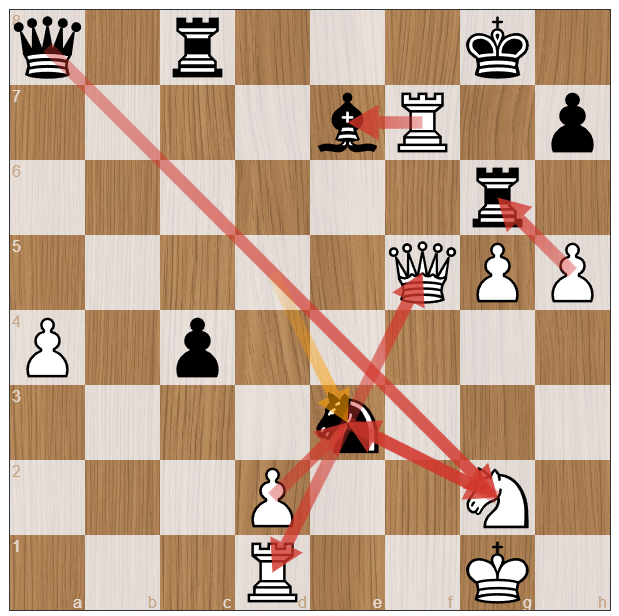ChessPuzzle.net Version 3: Checkmate Puzzles
I'm thrilled to announce a significant update to the puzzles on ChessPuzzle.net. This update is powered by a revamped version of the algorithm that generates the puzzles, which now takes advantage of the capabilities of modern neural network-based chess engines. Additionally, I've incorporated a range of improvements based on your valuable feedback.
This update marks the first in a series dedicated to the new algorithm version, focusing initially on our most popular puzzles — those featuring forced checkmates. Future updates will extend these enhancements to other types of puzzles. Let's explore what's new and exciting!
Integration with Advanced Neural Network-Based Stockfish
Three years ago, Stockfish revolutionized chess position evaluation by incorporating neural networks, following the pioneering work of DeepMind with AlphaZero. This innovation enabled Stockfish to identify advantageous or winning positions that were previously undetectable by engines, particularly in scenarios without material advantage. This led to more dynamic play and a significant leap in playing strength. However, utilizing these early neural network-based versions for generating chess puzzles was challenging due to fluctuating evaluations.
A breakthrough came in December 2022 with the introduction of Stockfish 15.1, featuring a normalized evaluation. Since this release, I have dedicated considerable time to recalibrating the puzzle algorithm to align with these newer versions of Stockfish, and recalculated more than 75,000 checkmate puzzles.
The enhanced Stockfish now offers much greater precision in identifying alternative winning strategies, particularly those moves that don't lead directly to checkmate or immediate material gain.
Benefit: If you sometimes play brilliant positional or dynamic moves that confused previous versions of Stockfish, these will all be accepted as correct now, or the flawed puzzles will be removed, as in the following example:
This used to be a puzzle. White has sacrificed three pawns for initiative. White has a forced win starting with 1.Nf6+ gxf6 2.Qg6+. However, new versions of Stockfish also give White a big advantage after 1.Qe4 or 1.Rhe1. Even though White is three pawns down, Stockfish now understands the position much better and values the initiative higher than the material. This puzzle has now been removed, because there are multiple winning moves in the starting position.
Supporting Suboptimal Checkmate Moves
Delivering checkmate often presents multiple viable paths, and in our previous algorithm, choosing a suboptimal yet valid checkmate route would sometimes trigger a "There is a better move" message. While the quickest checkmate is generally the easiest to find, there are exceptions where this isn't the case.
Consider the following example:
White proceeds with 1.Qxf7+ Kh8 2.Rd7 Qe3+ 3.g3 Rg8, reaching the following position:
Now there is an intuitive checkmate with 4.Qh5, for example 4...h6 5.Qxh6+ gxh6 6.Rh7#, or 5.Qg6 hxg5 6.Qh5#.
However, the previous algorithm would flag this as suboptimal because 4.Qf5! offers a faster checkmate, though it's far less obvious.
The new algorithm embraces flexibility in these scenarios. It now accepts any valid checkmate path without the restrictive "There is a better move" message, unless a selected move significantly delays the win.
Benefit: You can win in the way which is easiest for you.
Additionally, in puzzles labeled "Checkmate" where a quick checkmate is possible alongside other strong moves, the "There is a better move" message will now be shown for any winning move that does not lead to a quick checkmate.
In this puzzle, White can capture the rook with 1.Rxb5. However, there is a much easier way to win with 1.Ng3+ Ke3 2.Rf3# checkmate. Since this is a checkmate puzzle, previously playing Rxb5 would result in failed puzzle. Now the message "There is a better move" is shown instead, using the same rules as other puzzles.
Benefit: A better experience when solving puzzles, especially with mixed tasks.
Multiple reply moves supported in the solution view
In previous versions, the solution view only showed the move that the computer played against you. In the new version, alternate opponent moves are shown, including how to win against them.
In chess, the decision to sacrifice a piece for a potential checkmate is both thrilling and risky. It demands that you precicesly calculate all defensive moves of your opponent. If you overlook or miscalculate any of them, the intended sacrifice could be incorrect and refuted, and you could lose the game.
In this example, White can win with the spectacular Queen sacrifice 1.Qxh7+!!
Before playing this sacrifice, you have to calculate two variations:
1...Kxh7 2.Rh5#, and
1...Nxh7 2.Ng6#.
On the solution page, you can see and replay both of these variations.
Here is another beautiful example. Click on the diagram to solve this puzzle. Try to calculate all variations before playing the moves. Then click the "Solution" button and compare the variations shown with the variations you calculated.
Benefit: Practice to calculate multiple variations and see them on the solution page. This is an important skill for all chess players.
Improved opponent defends better
The algorithm's ability to play stronger defensive moves, including sacrifices, has been significantly enhanced.
Background: The computer opponent does not always play the "best" engine move, as that would often lead to weird sacrifices. For example, the engine would rather sacrifice the queen to prevent a complicated checkmate in many moves, instead of letting the solver show that he can find that checkmate.
In previous versions of ChessPuzzle.net, the computer opponent was therefore quite greedy, avoiding this issue. Here is an example where this worked well:
Black can win with 1...Kh6! 2.g4 Qg1. Here the "best" engine move is to sacrifice the queen with 3.Qe3, ending the puzzle in a weird and confusing way. The previous version of ChessPuzzle.net already improved upon this and played 3.gxh5 instead, requiring you to find the checkmate.
In the new version, the computer opponent is playing less greedy if this results in a better puzzle.
This puzzle is from a game between Wesley So and Magnus Carlsen. The world champion played the queen sacrifice 1...Qxf2!!. In previous versions, the computer opponent would accept the sacrifice 2.Rxf2, allowing the back-rank checkmate with 2...Rd1+. In the updated version, the computer opponent now plays 2.Qe1, the same move that Wesley So played, requiring you to find the second sacrifice with 2...Ng3+!!, with a forced checkmate after 3.hxg3 Rh5#.
This results in a more challenging and more beautiful puzzle. You can see all variations in the solution view.
This is a more complicated example. After the queen sacrifice 1.Qh5!, instead of grabbing the queen immediately, the computer opponent now plays the counter sacrifice 1...Bxf2+, making the win more difficult for the player.
Benefit:Improved puzzles, less confusing computer moves.
Updates to checkmate skills in Puzzle Academy
These changes will have some impact on checkmate skills included in Puzzle Academy. Because suboptimal checkmate sequences are now supported, some of the puzzles that previously required you to find a certain checkmate pattern or combination now offer alternate ways of solving. These puzzles will be removed from the corresponding skills, because you can now solve the puzzles without actually exercising the skill.
Benefit: This results in more precise training in Puzzle Academy, where the skills you learn better match the puzzles you practice.
The best checkmate puzzles
To celebrate this update I'm sharing with you five lists of the best checkmate puzzles. These are lists of great checkmate puzzles, which you can play through to learn and enjoy the beauty of chess. All puzzles were previously selected as Puzzle of the Day on ChessPuzzle.net, and were now recalculated with the new algorithm.
- Best Checkmate in 2 (58 puzzles, 1662 average rating)
- Best Checkmate in 3 (185 puzzles, 1672 average rating)
- Best Checkmate in 4 (174 puzzles, 1769 average rating)
- Best Checkmate in 5 (134 puzzles, 1836 average rating)
- Best Checkmate in 6 and more (122 puzzles, 1910 average rating)

keskiviikko 6. joulukuuta 2023
Martin Bennedik
Founder of ChessPuzzle.net, International Correspondence Chess Master
Related posts
Intermediate Chess Puzzles out, many updates to ChessPuzzle.net and Puzzle Academy!
New features and content in the latest updatePuzzle Academy Update: New Levels, Updated Guides, and More
Discover what’s new in Puzzle Academy! With new levels, refreshed guides based on my upcoming book, and puzzles powered by algorithm version 3, this update is packed with exciting enhancements.Puzzle Academy Update: New Skills, New Challenges
Stay ahead in your chess journey with the latest Puzzle Academy update! This release introduces fresh levels and skills, providing new opportunities to master key tactical concepts and sharpen your game.
